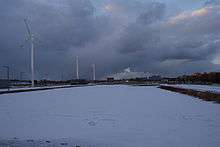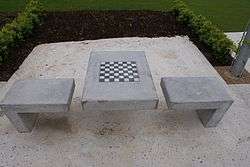Clongriffin
| Clongriffin Cluain Ghrífín | |
|---|---|
| Housing estate (suburb) | |
|
Outdoor chess at Father Collins Park | |
 Clongriffin Location in Ireland | |
| Coordinates: 53°24′05″N 6°09′12″W / 53.4013°N 6.153447°WCoordinates: 53°24′05″N 6°09′12″W / 53.4013°N 6.153447°W | |
| Country | Ireland |
| Province | Leinster |
| County | County Dublin (Dublin city) |
| Time zone | WET (UTC+0) |
| • Summer (DST) | IST (WEST) (UTC-1) |

Clongriffin (Irish: Cluain Ghrífín, meaning "meadow of the griffin")[1] is a new and unfinished locality near Donaghmede,[2] Dublin, Ireland. It is part of the ecclesiastical parish of "Donaghmede-Clongriffin-Balgriffin" in the Roman Catholic Archdiocese of Dublin.[3]
Name
The name Clongriffin is a modern invention, a concatenation of "clon", the anglicisation of cluain (the Irish language word for meadow) and griffin. A griffin, griffon, or gryphon (the Irish of which is ghrífín) is a mythical beast and is an element in the name of the adjacent district, Balgriffin.
Allegedly, architect David Wright gave Clongriffin its name while working on its development.[4]
Location
Clongriffin is 2 km (1.24 mi) inland from Baldoyle Bay and 10 km (6.21 mi) northeast of Dublin city centre, in northern Donaghmede, at the northern edge of Dublin's suburbs, in the jurisdiction of Dublin City Council. The development lies within the townland of Grange, in the civil parish of Baldoyle, from which Donaghmede was largely formed.
Clongriffin is in the Dublin Postal District Dublin 13, and in the constituency of Dublin North-East.
Transport and access
Road
Clongriffin is reached by Hole in the Wall Road from its junction with Grange Road and the N32 road, the latter in turn connecting to Malahide Road, and the M1 and M50 motorways.
Rail
Clongriffin railway station is situated along the Dublin–Belfast railway line between Howth Junction and Portmarnock railway station, and is served by Dublin Area Rapid Transit (DART) and InterCity (Iarnród Éireann).
A Park and Ride underground car park, with more than 500 spaces, is located on Clongriffin's Main Street.
Walking
There is a walking route with access across the railway lines to Baldoyle Bay.
Bus
Dublin Bus provides the 15 service which is one of Dublin's "cross town" routes.[5] It serves from Station Square, Clongriffin to Palmerston Park, Rathmines via Malahide Road, Dublin Connolly railway station, Nassau Street, Dublin, Saint Stephen's Green, Rathmines, Rathgar, Terenure, and Ballycullen.
A late night bus is provided by the 29N Nitelink service[6] from D'Olier Street to Baldoyle Road, stopping on Grange Road approximately one kilometre from Main Street, Clongriffin.
Amenities
Shopping
Clongriffin has an off-license, a chipper, Italian restaurant, a barber and a Chinese restaurant, most at the beginning of the main street. There are several empty retail units to let, some reserved for a bigger Centra shop, a betting shop, hair salon, and for other uses. An anchor store was promised from Superquinn but this will not proceed.
Existing shopping facilities nearby (between one and three kilometres away) include small shopping plazas at Baldoyle and Clare Hall, and the larger Donaghmede Shopping Centre and Clarehall Shopping Centre on Malahide Road.
Occasionally, a market is held at Station Square.
Cycling, walking, and running
Several pedestrian, running, and cycle routes meet at Station Square. From here, there is passage to Father Collins Park and beyond the civic steps to Dublin coastal walkways and Baldoyle Bay, the estuary of two rivers and a noted wetland, which was declared a nature reserve in 1988.
Father Collins Park
The redeveloped Father Collins Park, adjacent to Clongriffin, was officially reopened in May 2009 and is Ireland's first wind powered and "self-sustainable" public park.[7]
The park has since won a number of awards such as The Sustainability Award 2010, Best Public Space 2010, and Best Public Park & Best Environmentally Friendly Initiative for 2010.[8] It was short listed by the European Union Prize for Contemporary Architecture in 2011.
Five 50 kilowatt wind turbines provide power for the projection of water from its central lake, public lighting, maintenance depots, and sports club changing rooms.
The 54 acre (26 hectare) park includes some natural woodland. There is a peripheral running/cycling track, six playing pitches and six fitness stations. There are also a promenade, concert amphitheatre, and picnic areas with outdoor chess or draughts boards, two playgrounds and a skate park.
Education
Clongriffin has a crèche called The Learning Circle. Two new primary schools lie to the west of Clongriffin in the Belmayne development in Balgriffin, another constituent housing estate of the North Fringe. One of them, St. Francis of Assisi school, is under the patronage of the Roman Catholic Church and the other is an Educate Together (multi-denominational and co-educational) school. There are other primary and secondary schools nearby, in Donaghmede and Baldoyle.
Religion
The Holy Trinity Church[9] serves the Roman Catholic parishioners of Donaghmede-Clongriffin-Balgriffin Parish, created in 1974.
St Doulagh's Church, Balgriffin serves Church of Ireland parishioners[10] and has been used for services since the Tudor conquest of Ireland.
There were plans to build the largest Mosque in Ireland. The €40 million development will see the construction of the 157,000 Mosque and cultural centre, conference centre, primary school, secondary school, fitness centre and eight apartments and landscaped gardens.The mosque will cater for up to 3,000 people.
The latest report from Gannon Homes says that the construction of the Mosque will not go ahead due to lack of funding. The land will be used for residential development as originally planned.
Nature
Clongriffin is adjacent to Baldoyle Bay, with the estuaries of the Sluice River and Mayne River, and wetlands, all of which are protected by the National Parks and Wildlife Service.[14]
Declared a Statutory Nature Reserve in 1988,[15] the inner estuarine part of the estuary and wetlands of Baldoyle Bay are protected as a Special Area of Conservation (SAC).[16] Under the Ramsar Convention, the wetlands have been designated as of international importance. They support several habitats that are listed on the EU Habitats Directive.[17]
The open lands of Clongriffin and Father Collins Park host migrating birds, including Arctic and African-Eurasian migratory birds. The internationally important population of brent geese which frequent the broad area around Baldoyle Bay is of particular interest .[18][19]
There was until the late 1990s a stream running west and northwest from the southeastern corner of Father Collins Park (where Main Street now passes) to Stapolin and into the Grange Stream tributary of the Mayne River. This stream is no longer visible.
History and composition
Early history
The lands of Baldoyle, on which Clongriffin is situated, formed part of a large tract of high mediaeval monastic grange farmland, sometimes called the "Grange of Baldoyle." A reminder of this is the small church now called "Grange Abbey" to the south of Clongriffin. In 1166, the lands were assigned to All Saints Priory, on whose site Trinity College Dublin was later built, by Diarmait Mac Murchada, King of Leinster.[20]
In 1369, parliament was held in the small church, called by Sir William de Windsor.[21]
In the late 1530s, at the beginning of the Tudor conquest of Ireland, the entire settlement was invaded and seized at the behest of King Henry VIII of England, who in 1538 bestowed it on the Corporation of Dublin.
Modern history
Until 2003, most of the lands on which Clongriffin is being built were farmland.
In July of the same year Dublin City Council granted planning permission for a mixed-use development to be called "Clongriffin at Grange Road, Donaghmede"[2] now forming part of the Northern Fringe Development (from Clongriffin to Belmayne).[22]
Management plans were completed in 2004 and the development, comprising houses and apartments, started in 2005 and was planned to have educational, retail and service facilities, including a multi-screen cinema. Clonriffin was part of the Northern Fringe Development (along with Belmayne in Balgriffin and estates on the former Baldoyle Racecourse and in north Coolock) and was approved by the local authorities to provide new accommodation for Dublin on green belt land, and was to complete the development of north Donaghmede. Clongriffin's developments comprise Grange Lodge, Beau Park, Station Point and Marrsfield.[23]
For further history and general notes, see also the Donaghmede and Baldoyle articles.
Provision of services
No area of the estate has yet been taken in charge by Dublin City Council and the Council maintains that it has made no commitment in this respect.[2] Nevertheless, the Council, working with a private management company, perform refuse collection. However, the local community have been told that Irish Rail requested that Dublin City Council take Main Street in charge before the opening of the railway station.[24]
Pyrite settlement and remediation
In early 2008, it was alleged that the mineral pyrite was found in the stone hardcore used in the construction of some homes in various housing estates in north Dublin, including Beaupark in Clongriffin.[25] Pyrite remedition of affected ground level dwellings is underway[26] after a settlement was reached in March 2011 in a Commercial Court case. Menolly Homes[27] and The Lagan Group[28] accepted responsibility for the defective infill used, and have set up a trust fund to cover costs for remediation of all homes affected by pyrite in Clongriffin.[29] Remediation began in May 2011.
Road maintenance and other developments
Roads in the main Clongriffin development are thought to be maintained by Gannon Homes, however, responsibility for the upkeep of the roads remains under dispute.
Development has been stalled owing to such factors as the downturn in the Irish economy, developer financial problems, and reduced demand. Some areas remain enclosed by construction hoarding. Dublin City Council are formulating a Local Area Plan for the North Fringe[30] as part of the Dublin City Development Plan 2011–2017.[31]
References
- ↑ Clongriffin Placenames Database of Ireland. Retrieved: 2012-09-09.
- 1 2 3 Dublin: Dublin City Council, Minutes of full Meeting of Council, April 2009, Q. 36 - City Manager's answer.
- ↑ Dublin diocese - guidebook
- ↑ Sunday Independent LIFE Magazine, 2009-03-01, "Blame it all on the Lego"
- ↑ Dublin Bus 15 Service & Timetable
- ↑ Dublin Bus 29n Service & Timetable
- ↑ Dublin City Parks - Fr Collins Park
- ↑ KSN Energy
- ↑ Holy Trinity Church, Donaghmede-Clongriffin-Balgriffin Parish
- ↑ The United Parishes of Malahide, Portmarnock & St Doulagh's - Church of Ireland
- ↑ http://www.thejournal.ie/irelands-largest-mosque-clongriffin-1060199-Aug2013/
- ↑ http://www.independent.ie/irish-news/mosque-for-3000-gets-goahead-in-capital-29119030.html
- ↑ http://www.tommybroughan.com/wp-content/uploads/2015/03/TOMMY_BROUGHAN_TD_ONLINE_VOL_23_No_1.pdf
- ↑ National Parks and Wildlife Service (Ireland), Baldoyle Bay SPA 004016
- ↑ Irish Statute Book, S.I. No. 233/1988 — Nature Reserve (Baldoyle Estuary) Establishment Order, 1988
- ↑ Natural Heritage Designations, Baldoyle Bay
- ↑ Habitats Directive, Environmental Legislation
- ↑ National Parks and Wildlife Services, Baldoyle Bay Specially Protected Sites
- ↑ National Parks & Wildlife Services
- ↑ Grange Abbey, Baldoyle by Brian Mac Giolla Phadraigh. Dublin Historical Record @ 1965
- ↑ An article on Fingal district, by William C. Stubbs, M.A., in the Journal of the Royal Society of Antiquaries for 1897; Dalton's History of the County Dublin; Archdall's Monasticon Hibernicum (Moran's).
- ↑ Dublin City Council - Clongriffin – Belmayne (North Fringe)
- ↑ Clongriffin Town Centre
- ↑ North Area Assistant Manager at the Safer Belmayne/Clongriffin Forum, Shop Unit 60, Main St. Clongriffin, 19 May 2009.
- ↑ Report on presence of pyrite in Beaupark, Clongriffin to DCC North Central Area Committee
- ↑ The Planning and Development (Amendment) Act 2010
- ↑ Menolly Homes
- ↑ The Lagan Group
- ↑ Irish Times - Pyrite housing settlement outlined
- ↑ North Fringe Local Area Plan
- ↑ Dublin City Development Plan 2011-2017
